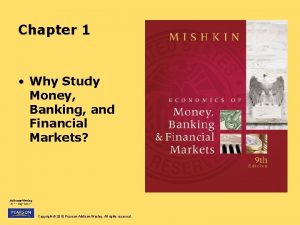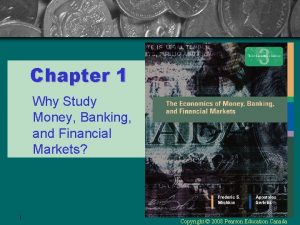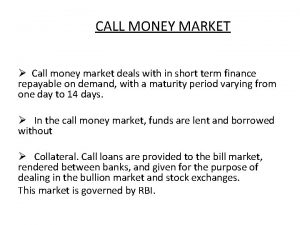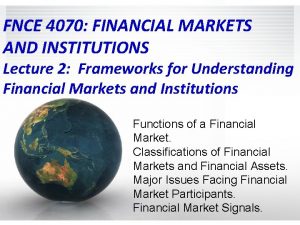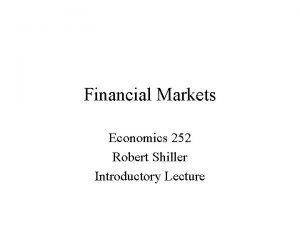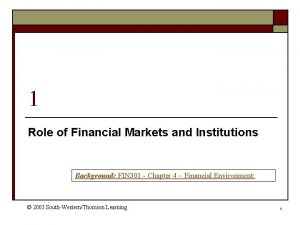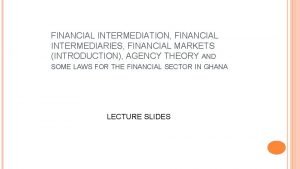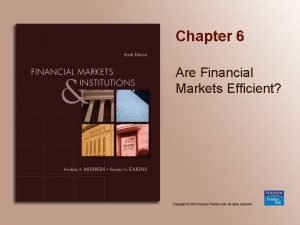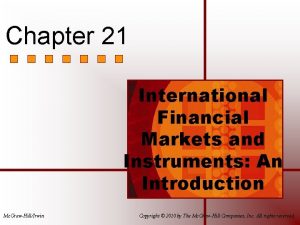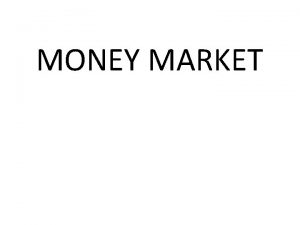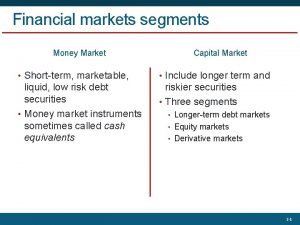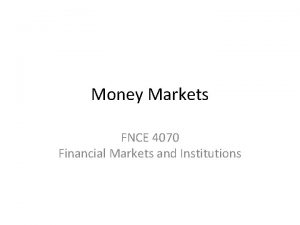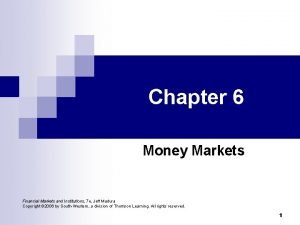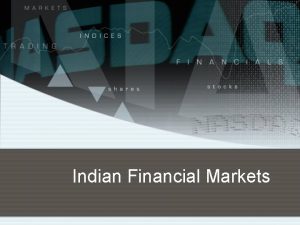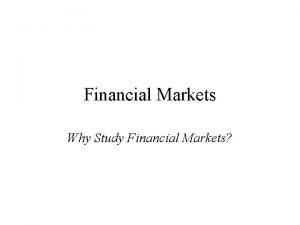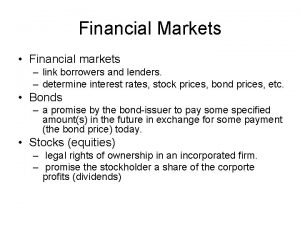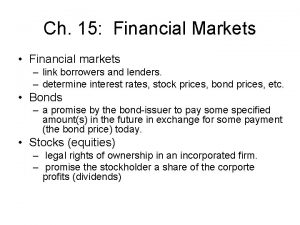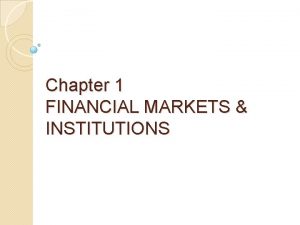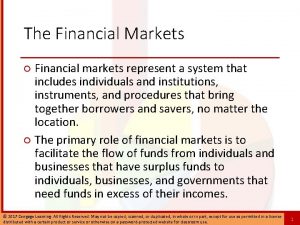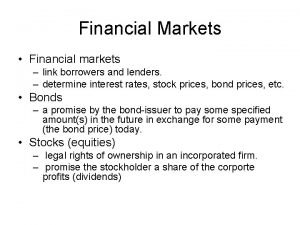FINANCIAL MARKETS MONEY MARKET Features of Money Market





















- Slides: 21

FINANCIAL MARKETS


MONEY MARKET

Features of Money Market q Issuing and trading of short term of debt. q. Liquidity surplus can be parked in the market for short term period. q. Short term liquidity problem of institutions can be solved. q. Instrument used are near substitute for money. q. Liquid market.

q Over-the- phone market- No fixed geographical location. q. Leads in monetary policy transmission. q RBI- Central Bank is a regulator. q. Wholesale market. q. Commercial banks are essential part of this market.

q Other institutions like MF, LIC, GIC etc. are involved in this market. q. Government may borrow short term funds to finance their budget deficit. q. Importance of money market has increased because of globalisation. q Corporations have been approaching international money market to raise fund. (why? ) q. Interest rates in developing countries are typically higher than rates in other countries.

Sub-Parts of Money Market q Interbank Call Money Market. q. Treasury Bill Market. q. Commercial Paper Market q. Certificate of Deposit q. Commercial bill Marekt

Inter Bank Call Money Market q. Borrowing and lending for very short duration ranging from overnight to a fortnight. q. Call loans repayable on demand at the option of the borrower or lender at very short notice. q. Call money market is a most sensitive segment of financial system. q‘Call money’ is for a day. (excluding Holidays and Sundays). q. If the period is more than one day and up to 14 days it is called 'Notice money’. q. Money lent for 15 days to 1 year is called 'Term money'.

q. Maintenance of liquidity and reserve requirement. q Temporary existing surplus can be put in a call market. q. Basically operated over a telephone. q. Commercial banks, primary dealers and authorised financial institution are allowed to operate. q. Interest rate in a call money market are market determined.



Treasury Bill market q Treasury Bills are short term borrowing instrument of Government. q. Monetary management in a economy is done through treasury bills. q. High degree of liquidity. q. Strong secondary market. q treasury bills are kind of finance bill, they do not arise due to the commercial transaction.

q Treasury Bills were first issued by Bank of England in 1877. q. In India, Treasury Bills were first issued in 1917 for raising resources for war. q. Initially, maturities decided by the government were 3 months, 6 months, 9 months and 12 months. q treasury bills do not pay any interest amount to their investors. As they are issued at discount in the market. (zero coupon securities)

q treasury bills are issued for 91 day, 182 day and 364 day. q In 2010, Government of India, in consultation with RBI introduced a new short-term instrument, known as Cash Management Bills (CMBs), to meet the temporary mismatches in the cash flow of the Government of India. q Yield on treasury bills -

Commercial Paper q Commercial Paper is a short term debt instrument issued by well- known, creditworthy company. q. Unsecured q Individual investors rarely purchase Commercial Paper directly. q. Lack of active secondary market. q As per RBI rules, corporates who get an investment grade rating can only issue CP in the Indian money market.

q The minimum credit rating shall be A-2 [As per rating symbol and definition prescribed by Securities and Exchange Board of India (SEBI)]. q. Commercial Paper was introduced in India in 1990. q. CP can be issued for maturities between a minimum of 7 days and a maximum of up to one year from the date of issue. q. CP can be issued in denominations of Rs. 5 lakh or multiples thereof.

Lehman’s Default

Commercial Paper Crisis in India DHFL defaults again on commercial papers repayment - The Economic Times. pdf IL&FS defaults hit commercial paper market, October sales dip 65% - The Economic Times. pdf

Certificate of Deposit q Certificate of Deposit (CD) is a negotiable money market instrument and issued in dematerialised form against funds deposited at a bank for a specified time period. q. CDs can be issued by (i) scheduled commercial banks {excluding Regional Rural Banks and Local Area Banks}; and (ii) select All-India Financial Institutions (FIs) that have been permitted by RBI. q the minimum deposit that could be accepted from a single subscriber should not be less than Rs. 1 lakh, and in multiples of Rs. 1 lakh thereafter. q. The maturity period of CDs issued by banks should not be less than 7 days and not more than one year, from the date of issue.


 Why study money banking and financial markets
Why study money banking and financial markets Why study money banking and financial markets
Why study money banking and financial markets Money money money team
Money money money team Capital market and money market
Capital market and money market Call loans
Call loans Features of money market
Features of money market Digital market and digital goods
Digital market and digital goods Unique features of digital markets
Unique features of digital markets Why study financial markets
Why study financial markets Financial intermediation ppt
Financial intermediation ppt Classification of financial markets
Classification of financial markets Financial market classification
Financial market classification Financial markets shiller
Financial markets shiller Classification of financial markets
Classification of financial markets Classification of financial markets
Classification of financial markets Role of financial markets and institutions
Role of financial markets and institutions Financial institutions and markets lecture notes ppt
Financial institutions and markets lecture notes ppt Financial intermediary
Financial intermediary Are financial markets efficient
Are financial markets efficient International financial markets and instruments
International financial markets and instruments Capital markets and financial intermediation
Capital markets and financial intermediation Levich international financial markets
Levich international financial markets
